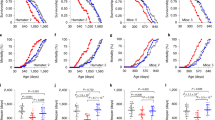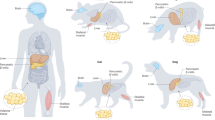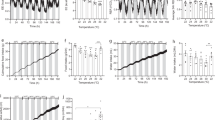Abstract
It is standard practice in preclinical biomedical research to house mammalian model organisms at an ambient temperature substantially below the thermoneutral zone. These experimental studies are performed using animals that are chronically challenged by mild cold stress. This condition increases food intake, metabolic rate, sympathetic activity, blood pressure and heart rate. Furthermore, this condition alters the behavioral and physiological responses to drug administration, energy restriction and overfeeding. This paper will review these observations, which must be understood in the context of phenotyping small mammals to enhance our understanding of the biology of human disease.
This is a preview of subscription content, access via your institution
Access options
Subscribe to this journal
Receive 12 print issues and online access
$259.00 per year
only $21.58 per issue
Buy this article
- Purchase on Springer Link
- Instant access to full article PDF
Prices may be subject to local taxes which are calculated during checkout
Similar content being viewed by others
References
IUPS Thermal Commission. Glossary of terms for thermal physiology. Third edition. Revised by The Commission for Thermal Physiology of the International Union of Physiological Sciences (IUPS Thermal Commission). Jpn J Physiol 2001; 51: 245–280.
Romanovsky AA . Thermoregulation: some concepts have changed. Functional architecture of the thermoregulatory system. Am J Physiol 2007; 292: R37–R46.
Romanovsky AA, Almeida MC, Garami A, Steiner AA, Norman MH, Morrison SF et al. The transient receptor potential vanilloid-1 channel in thermoregulation: a thermosensor it is not. Pharmacol Rev 2009; 61: 228–261.
Herrington LP . The heat regulation of small laboratory animals at various environmental temperatures. Am J Physiol 1940; 129: 123–139.
Swift RW . The effect of feed on the critical temperature for the albino rat. J Nutr 1944; 28: 359–364.
Gordon CJ . Behavioral and autonomic thermoregulation in the rat following propylthiouracil-induced hypothyroidism. Pharmacol Biochem Behav 1997; 58: 231–236.
Mount LE . Metabolic rate and thermal insulation in albino and hairless mice. J Physiol 1971; 217: 315–326.
Rudaya AY, Steiner AA, Robbins JR, Dragic AS, Romanovsky AA . Thermoregulatory responses to lipopolysaccharide in the mouse: dependence on the dose and ambient temperature. Am J Physiol 2005; 289: R1244–R1252.
Gordon CJ . Relationship between autonomic and behavioral thermoregulation in the mouse. Physiol Behav 1985; 34: 687–690.
Romsos DR, Ferguson D, Vander Tuig JG . Effects of a warm environment on energy balance in obese (ob/ob) mice. Metabolism 1985; 34: 931–937.
Trayhurn P, James WP . Thermoregulation and non-shivering thermogenesis in the genetically obese (ob/ob) mouse. Pflugers Arch 1978; 373: 189–193.
Kaplan ML, Leveille GA . Core temperature, O2 consumption, and early detection of ob-ob genotype in mice. Am J Physiol 1974; 227: 912–915.
Himms-Hagen J, Desautels M . A mitochondrial defect in brown adipose tissue of the obese (ob/ob) mouse: reduced binding of purine nucleotides and a failure to respond to cold by an increase in binding. Biochem Biophys Res Commun 1978; 83: 628–634.
Himms-Hagen J . On raising energy expenditure in ob/ob mice. Science 1997; 276: 1132–1133.
Arch JR, Hislop D, Wang SJ, Speakman JR . Some mathematical and technical issues in the measurement and interpretation of open-circuit indirect calorimetry in small animals. Int J Obes (Lond) 2006; 30: 1322–1331.
Cannon B, Nedergaard J . Brown adipose tissue: function and physiological significance. Physiol Rev 2004; 84: 277–359.
Richard D, Carpentier AC, Doré G, Ouellet V, Picard F . Determinants of brown adipocyte development and thermogenesis. Int J Obes 2010; 34 (Suppl 2): S59–S66.
Morrison SF . Differential control of sympathetic outflow. Am J Physiol 2001; 281: R683–R698.
Rothwell NJ, Stock MJ . A role for brown adipose tissue in diet-induced thermogenesis. Nature 1979; 281: 31–35.
Stock MJ . Gluttony and thermogenesis revisited. Int J Obes 1999; 23: 1105–1117.
Overton JM, Williams TD, Chambers JB, Rashotte ME . Cardiovascular and metabolic responsese to fasting and thermoneutrality are conserved in obese Zucker rats. Am J Physiol 2001; 280: R1007–R1015.
Williams TD, Chambers JB, Henderson RP, Rashotte ME, Overton JM . Cardiovascular responses to caloric restriction and thermoneutrality in C57BL/6J mice. Am J Physiol 2002; 282: R1459–R1467.
Richard D, Labrie A, Rivest S . Tissue specificity of SNS response to exercise in mice exposed to low temperatures. Am J Physiol 1992; 262 (Part 2): R921–R925.
Janssen BJA, Smits JFM . Autonomic control of blood pressure in mice: basic physiology and effects of genetic modification. Am J Physiol 2002; 282: R1545–R1564.
Swoap SJ, Overton JM, Garber G . Effect of ambient temperature on cardiovascular parameters in rats and mice: a comparative approach. Am J Physiol 2004; 287: R391–R396.
Kurtz TW, Griffin KA, Bidani AK, Davisson RL, Hall JE . Recommendations for blood pressure measurement in humans and experimental animals. Part 2: Blood pressure measurement in experimental animals: a statement for professionals from the subcommittee of professional and public education of the American Heart Association council on high blood pressure research. Hypertension 2005; 45: 299–310.
Swoap SJ, Li C, Wess J, Parsons AD, Williams TD, Overton JM . Vagal tone dominates autonomic control of mouse heart rate at thermoneutrality. Am J Physiol 2008; 294: H1581–H1588.
Bachman ES, Dhillon H, Zhang C-Y, Cinti S, Bianco AC, Kobilka BK et al. Beta AR signaling required for diet-induced thermogenesis and obesity resistance. Science 2002; 297: 843–845.
Wess J . Muscarinic acetylcholine receptor knockout mice: novel phenotypes and clinical implications. Annu Rev Pharmacol Toxicol 2004; 44: 423–450.
Gehrmann J, Hammer PE, Maguire CT, Wakimoto H, Triedman JK, Berul CI . Phenotypic screening for heart rate variability in the mouse. Am J Physiol 2000; 279: H733–H740.
Thomas SA, Palmiter RD . Thermoregulatory and metabolic phenotypes of mice lacking noradrenaline and adrenaline. Nature 1997; 387: 94–97.
Melnyk A, Himms-Hagen J . Temperature-dependent feeding: lack of role for leptin and defect in brown adipose tissue-ablated obese mice. Am J Physiol 1998; 274 (Part 2): R1131–R1135.
Yu XX, Lewin DA, Forrest W, Adams SH . Cold elicits the simultaneous induction of fatty acid synthesis and beta-oxidation in murine brown adipose tissue: prediction from differential gene expression and confirmation in vivo. FASEB J 2002; 16: 155–168.
Himms-Hagen J . Role of brown adipose tissue thermogenesis in control of thermoregulatory feeding in rats: a new hypothesis that links thermostatic and glucostatic hypotheses for control of food intake. Proc Soc Exp Biol Med 1995; 208: 159–169.
Alfoldi P, Rubicsek G, Cserni G, Obal Jr F . Brain and core temperatures and peripheral vasomotion during sleep and wakefulness at various ambient temperatures in the rat. Pflugers Arch 1990; 417: 336–341.
Szymusiak R, Satinoff E . Maximal REM sleep time defines a narrower thermoneutral zone than does minimal metabolic rate. Physiol Behav 1981; 26: 687–690.
Brown D, Livesey G, Dauncey MJ . Influence of mild cold on the components of 24 h thermogenesis in rats. J Physiol 1991; 441: 137–154.
Mount LE, Willmott JV . The relation between spontaneous activity, metabolic rate and the 24 h cycle in mice at different environmental temperatures. J Physiol 1967; 190: 371–380.
Kaul R, Heldmaier G, Schmidt I . Defective thermoregulatory thermogenesis does not cause onset of obesity in Zucker rats. Am J Physiol 1990; 259 (Part 1): E11–E18.
Young JB, Shimano Y . Effects of rearing temperature on body weight and abdominal fat in male and female rats. Am J Physiol 1998; 274 (Part 2): R398–R405.
Nijkamp FP, Ezer J, De Jong W . Central inhibitory effect of alpha-methyldopa on blood pressure, heart rate and body temperature of renal hypertensive rats. Eur J Pharmacol 1975; 31: 243–249.
Preston E, Ma S, Haas N . Ambient temperature modulation of fenfluramine-induced thermogenesis in the rat. Neuropharmacology 1990; 29: 277–283.
Bouali SM, Fournier A, St-Pierre S, Jolicoeur FB . Influence of ambient temperature on the effects of NPY on body temperature and food intake. Pharmacol Biochem Behav 1995; 50: 473–475.
Harris RB, Mitchell TD, Kelso EW, Flatt WP . Changes in environmental temperature influence leptin responsiveness in low- and high-fat-fed mice. Am J Physiol 2007; 293: R106–R115.
Hogberg H, Engblom L, Ekdahl A, Lidell V, Walum E, Alberts P . Temperature dependence of o2 consumption; opposite effects of leptin and etomoxir on respiratory quotient in mice. Obesity (Silver Spring) 2006; 14: 673–682.
Rafael J, Herling AW . Leptin effect in ob/ob mice under thermoneutral conditions depends not necessarily on central satiation. Am J Physiol 2000; 278: R790–R795.
Stehling O, Doring H, Nuesslein-Hildesheim B, Olbort M, Schmidt I . Leptin does not reduce body fat content but augments cold defense abilities in thermoneutrally reared rat pups. Pflugers Arch 1997; 434: 694–697.
Saris WH . Effects of energy restriction and exercise on the sympathetic nervous system. Int J Obes 1995; 19 (Suppl 7): S17–S23.
Lane MA, Baer DJ, Rumpler WV, Weindruch R, Ingram DK, Tilmont EM et al. Calorie restriction lowers body temperature in rhesus monkeys, consistent with a postulated anti-aging mechanism in rodents. Proc Natl Acad Sci USA 1996; 93: 4159–4164.
Rashotte ME, Ackert AM, Overton JM . Ingestive behavior and body temperature during the ovarian cycle in normotensive and hypertensive rats. Am J Physiol 2002; 282: R216–R225.
Rikke BA, Yerg III JE, Battaglia ME, Nagy TR, Allison DB, Johnson TE . Strain variation in the response of body temperature to dietary restriction. Mech Ageing Dev 2003; 124: 663–678.
Ahima RS, Prabakaran D, Mantzoros C, Qu D, Lowell B, Maratos-Flier E et al. Role of leptin in the neuroendocrine response to fasting. Nature 1996; 382: 250–252.
Young JB, Landsberg L . Suppression of sympathetic nervous system during fasting. Science 1977; 196: 1473–1475.
Rappaport EB, Young JB, Landsberg L . Initiation, duration and dissipation of diet-induced changes in sympathetic nervous system activity in the rat. Metabolism 1982; 31: 143–146.
Woods SC, Seeley RJ, Porte Jr D, Schwartz MW . Signals that regulate food intake and energy homeostasis. Science 1998; 280: 1378–1383.
Migliorini RH, Garofalo MA, Kettelhut IC . Increased sympathetic activity in rat white adipose tissue during prolonged fasting. Am J Physiol 1997; 272 (Part 2): R656–R661.
Rosenbaum M, Goldsmith R, Bloomfield D, Magnano A, Weimer L, Heymsfield S et al. Low-dose leptin reverses skeletal muscle, autonomic, and neuroendocrine adaptations to maintenance of reduced weight. J Clin Invest 2005; 115: 3579–3586.
Himms-Hagen J . Physiological roles of the leptin endocrine system: differences between mice and humans. Crit Rev Clin Lab Sci 1999; 36: 575–655.
Melvin RG, Andrews MT . Torpor induction in mammals: recent discoveries fueling new ideas. Trends Endocrinol Metab 2009; 20: 490–498.
Hudson JW . Shallow daily torpor: a thermoregulatory adaptation. In: Lch W, Jw H (eds) Strategies in the Cold: Natural Torpidity and Thermogenesis. Academic Press: New York, 1978. pp 67–108.
Swan H . Thermoregulation and Bioenergetics. Elsevier: New York, 1974.
Hudson JW, Scott IM . Daily torpor in the laboratory mouse, Mus musculus var. albino. Physiol Zool 1979; 52: 205–218.
Webb GP, Jagot SA, Jakobson ME . Fasting-induced torpor in Mus musculus and its implications in the use of murine models for human obesity studies. Comp Biochem Physiol A 1982; 72: 211–219.
Stamper JL, Dark J . Metabolic fuel availability influences thermoregulation in deer mice (Peromyscus maniculatus). Physiol Behav 1997; 61: 521–524.
Himms-Hagen J . Food restriction increases torpor and improves brown adipose tissue thermogenesis in ob/ob mice. Am J Physiol 1985; 248 (Part 1): E531–E539.
Duffy PH, Feuers RJ, Leakey JA, Nakamura K, Turturro A, Hart RW . Effect of chronic caloric restriction on physiological variables related to energy metabolism in the male Fischer 344 rat. Mech Ageing Dev 1989; 48: 117–133.
Yoda T, Crawshaw LI, Yoshida K, Su L, Hosono T, Shido O et al. Effects of food deprivation on daily changes in body temperature and behavioral thermoregulation in rats. Am J Physiol 2000; 278: R134–R139.
Duffy PH, Feuers RJ, Pipkin JL, Turturro A, Hart RW . Age and temperature related changes in behavioral and physiological performance in the Peromyscus leucopus mouse. Mech Ageing Dev 1997; 95: 43–61.
Overton JM, Williams TD . Behavioral and physiologic responses to caloric restriction in mice. Physiol Behav 2004; 81: 749–754.
Sakurada S, Shido O, Sugimoto N, Hiratsuka Y, Yoda T, Kanosue K . Autonomic and behavioural thermoregulation in starved rats. J Physiol 2000; 526 (Part 2): 417–424.
Dulloo AG, Seydoux J, Girardier L . Dissociation of enhanced efficiency of fat deposition during weight recovery from sympathetic control of thermogenesis. Am J Physiol 1995; 269 (Part 2): R365–R369.
Barr HG, McCracken KJ . High efficiency utilization in ‘cafeteria’- and force-fed rats kept at 29°. Br J Nutr 1984; 51: 379–387.
Ma SW, Foster DO . Brown adipose tissue, liver, and diet-induced thermogenesis in cafeteria diet-fed rats. Can J Physiol Pharmacol 1989; 67: 376–381.
Desautels M . Mitochondrial thermogenin content is unchanged during atrophy of BAT of fasting mice. Am J Physiol 1985; 249 (Part 1): E99–E106.
Golozoubova V, Cannon B, Nedergaard J . UCP1 is essential for adaptive adrenergic nonshivering thermogenesis. Am J Physiol Endocrinol Metab 2006; 291: E350–E357.
Enerback S, Jacobsson A, Simpson EM, Guerra C, Yamashita H, Harper ME et al. Mice lacking mitochondrial uncoupling protein are cold-sensitive but not obese [see comments]. Nature 1997; 387: 90–94.
Hofmann WE, Liu X, Bearden CM, Harper M-E, Kozak LP . Effects of genetic background on thermoregulation and fatty acid-induced uncoupling of mitochondria in UCP1-deficient mice. J Biol Chem 2001; 276: 12460–12465.
Golozoubova V, Hohtola E, Matthias A, Jacobsson A, Cannon B, Nedergaard J . Only UCP1 can mediate adaptive nonshivering thermogenesis in the cold. FASEB J 2001; 15: 2048–2050.
Liu X, Rossmeisl M, McClaine J, Kozak LP . Paradoxical resistance to diet-induced obesity in UCP1-deficient mice. J Clin Invest 2003; 111: 399–407.
Feldmann HM, Golozoubova V, Cannon B, Nedergaard J . UCP1 ablation induces obesity and abolishes diet-induced thermogenesis in mice exempt from thermal stress by living at thermoneutrality. Cell Metab 2009; 9: 203–209.
Lodhi IJ, Semenkovich CF . Why we should put clothes on mice. Cell Metab 2009; 9: 111–112.
Author information
Authors and Affiliations
Corresponding author
Ethics declarations
Competing interests
The author declares no conflict of interest.
Rights and permissions
About this article
Cite this article
Overton, J. Phenotyping small animals as models for the human metabolic syndrome: thermoneutrality matters. Int J Obes 34 (Suppl 2), S53–S58 (2010). https://doi.org/10.1038/ijo.2010.240
Published:
Issue Date:
DOI: https://doi.org/10.1038/ijo.2010.240
Keywords
This article is cited by
-
Significance of variation in basal metabolic rate in laboratory mice for translational experiments
Journal of Comparative Physiology B (2022)
-
Aging mitigates the severity of obesity-associated metabolic sequelae in a gender independent manner
Nutrition & Diabetes (2021)
-
Impact of ambient temperature on inflammation-induced encephalopathy in endotoxemic mice—role of phosphoinositide 3-kinase gamma
Journal of Neuroinflammation (2020)
-
Neuropeptide Y Regulation of Energy Partitioning and Bone Mass During Cold Exposure
Calcified Tissue International (2020)
-
Reduced ambient temperature exacerbates SIRS-induced cardiac autonomic dysregulation and myocardial dysfunction in mice
Basic Research in Cardiology (2019)



